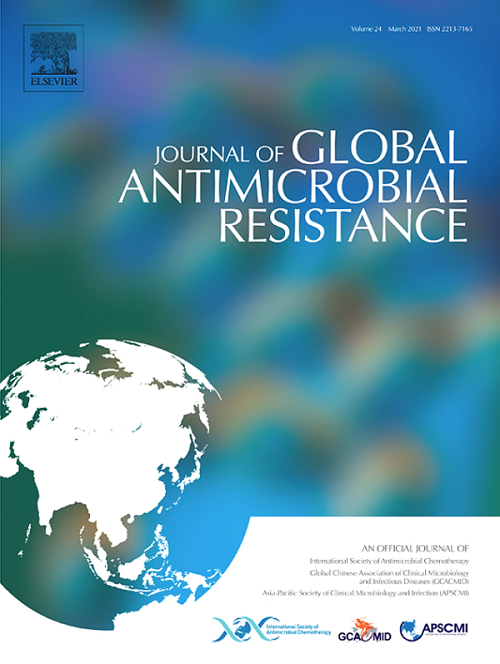肺炎克雷伯菌对头孢他啶-阿维巴坦的耐药性:2019-2024年不同亚系中日益增长的公共卫生问题
IF 3.2
3区 医学
Q2 INFECTIOUS DISEASES
引用次数: 0
摘要
目的:对最后一线β-内酰胺类抗生素耐药的菌株构成全球公共卫生威胁,需要密切监测和采取行动。本研究调查了葡萄牙北部肺炎克雷伯菌感染分离株6年间头孢他啶-阿维巴坦(CAZ-AVI)的耐药率。方法:采用梯度扩散法对2019年5月至2024年2月鉴定的539株碳青霉烯类耐药或kpc阳性肺炎克雷伯菌进行CAZ-AVI耐药筛选。分别使用基质辅助激光解吸/电离飞行时间质谱法和VITEK 2自动化系统进行物种鉴定和抗菌药敏试验。通过圆盘扩散证实了对CAZ-AVI的抗性和扩展敏感性。通过傅里叶变换红外光谱、全基因组测序或聚合酶链反应和测序进一步鉴定对CAZ-AVI具有抗性或敏感性降低的分离株。结果:我们观察到CAZ-AVI的平均耐药率为1.7%,随着CAZ-AVI使用量的增加,该耐药率在covid - 19后增加(2021年为1.1%至2022年为2.7%)。值得注意的是,caz - avi耐药菌株还表现出对尚未在常规临床实践中引入的最后一线β-内酰胺类药物(头孢地罗89%,亚胺培南-勒巴坦33%,美罗培南-瓦博巴坦22%)的耐药性。对CAZ-AVI的抗性与多种KPC-3变体(KPC-31、KPC-46、KPC-66)、IMP-22或DHA-1的产生有关,通常与孔蛋白缺乏相结合。鉴定了一个多克隆群体,包括通常与KPC-3产生相关的高风险亚系(ST147-KL64和ST323-KL21)。所有患者先前均暴露于不同的β-内酰胺,包括5例CAZ-AVI。结论:我们的研究结果强调了碳青霉烯类耐药肺炎克雷伯菌的管理情况,并强调了对最后一线抗生素进行常规实验室检测和实施有效抗菌药物管理指南的必要性。本文章由计算机程序翻译,如有差异,请以英文原文为准。
Ceftazidime-avibactam resistance in Klebsiella pneumoniae: A growing public health concern across diverse sublineages, 2019–2024
Objectives
Strains resistant to last-line β-lactam antibiotics pose a global public health threat, requiring close monitoring and action. This study investigated ceftazidime-avibactam (CAZ-AVI) resistance rates among Klebsiella pneumoniae infection isolates from northern Portugal in a 6-year period.
Methods
A total of 539 carbapenem-resistant or KPC-positive K. pneumoniae isolates identified between May 2019 and February 2024 were screened for CAZ-AVI resistance by gradient diffusion. Species identification and antimicrobial susceptibility testing were performed using matrix-assisted laser desorption/ionization time-of-flight mass spectrometry and VITEK 2 automated systems, respectively. CAZ-AVI resistance and extended susceptibility profiles were confirmed by disk diffusion. Isolates exhibiting resistance or reduced susceptibility to CAZ-AVI were further characterized by Fourier-transform infrared spectroscopy and whole genome sequencing or polymerase chain reaction and sequencing.
Results
We observed an average CAZ-AVI resistance rate of 1.7%, which increased post-COVID19 (1.1% in 2021 to 2.7% in 2022) alongside rising CAZ-AVI usage. Notably, CAZ-AVI-resistant isolates also exhibited resistance to last-line β-lactams not yet introduced in routine clinical practice (89% cefiderocol, 33% imipenem-relebactam and 22% meropenem-vaborbactam). Resistance to CAZ-AVI was associated with production of diverse KPC-3 variants (KPC-31, KPC-46, KPC-66), IMP-22 or DHA-1 often in combination with porin deficiencies. A multiclonal population was identified, including high-risk sublineages commonly linked to KPC-3 production (ST147-KL64 and ST323-KL21). All patients had prior exposure to different β-lactams, including CAZ-AVI in five cases.
Conclusions
Our findings highlight a concerning scenario for managing carbapenem-resistant K. pneumoniae and underscore the need for routine laboratory testing of last-line antibiotics and the implementation of effective antimicrobial stewardship guidelines.
求助全文
通过发布文献求助,成功后即可免费获取论文全文。
去求助
来源期刊

Journal of global antimicrobial resistance
INFECTIOUS DISEASES-PHARMACOLOGY & PHARMACY
CiteScore
8.70
自引率
2.20%
发文量
285
审稿时长
34 weeks
期刊介绍:
The Journal of Global Antimicrobial Resistance (JGAR) is a quarterly online journal run by an international Editorial Board that focuses on the global spread of antibiotic-resistant microbes.
JGAR is a dedicated journal for all professionals working in research, health care, the environment and animal infection control, aiming to track the resistance threat worldwide and provides a single voice devoted to antimicrobial resistance (AMR).
Featuring peer-reviewed and up to date research articles, reviews, short notes and hot topics JGAR covers the key topics related to antibacterial, antiviral, antifungal and antiparasitic resistance.
 求助内容:
求助内容: 应助结果提醒方式:
应助结果提醒方式:


